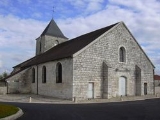
Colombey-les-Deux-Églises
Overview
Communes of France
The commune is the lowest level of administrative division in the French Republic. French communes are roughly equivalent to incorporated municipalities or villages in the United States or Gemeinden in Germany...
in the Haute-Marne
Haute-Marne
Haute-Marne is a department in the northeast of France named after the Marne River.-History:Haute-Marne is one of the original 83 departments created during the French Revolution on March 4, 1790...
department in north-eastern France
France
The French Republic , The French Republic , The French Republic , (commonly known as France , is a unitary semi-presidential republic in Western Europe with several overseas territories and islands located on other continents and in the Indian, Pacific, and Atlantic oceans. Metropolitan France...
.
The municipality Colombey-les-Deux-Eglises was created administratively in 1793, and it became part of the district of Chaumont
Arrondissement of Chaumont
The arrondissement of Chaumont is an arrondissement of France, located in the Haute-Marne département, in the Champagne-Ardenne région...
and the canton Blaise
Blaise
Blaise is a personal name and a place name. It can refer to:-France:* Blaise-sous-Arzillières, a village and commune in the Marne département of north-eastern France...
. In 1801, under the name Colombey, it passed to the canton Juzennecourt
Juzennecourt
Juzennecourt is a commune in the Haute-Marne department in north-eastern France....
. In 1972, it absorbed the communes Argentolles, Biernes, Blaise, Champcourt, Harricourt, Pratz and Lavilleneuve-aux-Fresnes.
Colombey achieved fame as the home and burial site of the 20th century French soldier and statesman Charles de Gaulle
Charles de Gaulle
Charles André Joseph Marie de Gaulle was a French general and statesman who led the Free French Forces during World War II. He later founded the French Fifth Republic in 1958 and served as its first President from 1959 to 1969....
who acquired a substantial property on the south-western edge of the village in 1934.

